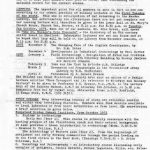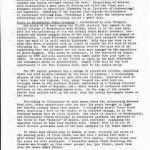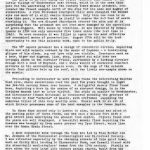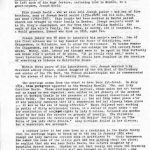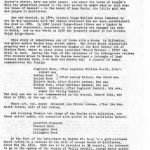Page 1
After a long and dry summer that we hope will have given members a tonic climate, they will enjoy the winter programme that is planned. It has been a busy and energetic some for many members, since apart from the usual outings there was an extra one for which an account appears later in this newsletter. The Dig Has Been Proceeding Near St. Mary’s Church In Hendon, And It Is Hoped that Ted Sammes will give a report on this in our next newsletter. Details of the last outing for this season — to Middleton Stoney and Blenheim Palace — on 15 September are enclosed, and we do hope that members will join in force, thus continuing their splendid record for the current season.
Lectures
The important point for members to note is that we are now reverting to our 1normal practise of holding lectures on the first Tuesday of the month. This was in anticipation of are returning to the Hendon Library, but unfortunately the alterations there are not yet complete and our opening lecture will therefore be given in the lower hall at St. Mary’s Church House, Church End, Hendon, at 8.15 p.m of turned for 8.30 p.m. on Tuesday 2 October 1973, when one of our members, Mr Eric Grant, will speak on “The St. Ninian’s Isle Treasure” — the discovery of an eight century silver hoard in Shetland. Subsequent lectures are set out below and it is hoped that they will be held at the library from November onwards at 8.15 p.m. for 8.30 p.m.
1973 November 6 The Changing Face of the English Countryside, by Dr. E. M. Yates
December 4 Developments in Industrial Archaeology, by Paul Carter
1974 January 1 Field Archaeology – Recognition of Sites and Problems Associated with Motorway Building, by Harvey Sheldon and Bernard Johnson
February 5 Rome and the East, by Malcolm A. R. Colledge
March 5 Documents and Manuscripts in the Westminster Abbey Library, by N. H. MacMichael
April 2 Verulamium, by D. Gareth Davies.
The Railway and Canal Historical Society have sent us notice of a Public Lecture entitled “Road Transport and its relevance to Waterway and Railway History” to be given by Professor T. C. Barker, M.A., Ph.D., in the Lecture Hall of the Science Museum, SW7 on Saturday 6 October at 5.30 p.m. Admission free but by ticket only, obtainable from: A. C. F. Hadfield.
Study Courses
1. Diploma in Archaeology
Early Man (Year 1). This course is primarily concerned with the hunting peoples of the Pleistocene epoch and their natural background. It also provides a broad introduction to archaeology (Weds. 7.30-9.30 – Desmond M. Collins, M.A.)
The Archaeology of Western Asia (Year 2). From the beginnings of settlement and early farming communities through the period leading up to the first cities in the Near East. (Tuesdays 7.30-9.30 – D. Price Williams, B.A.)
2 Geneaology and Palaeography – an introductory course discussing early examples of pedigree, Census Returns, Parish Registers, Wills, etc. Palaeography and its sources will also be considered and a visit arranged to the College of Arms. (Thursday 8-9.30 p.m. – Stella Colwell, B. A.)
Golders Green Library
Roman Archaeology (Tuesdays 8 p.m. – Mrs. M. M. Roxan)
Barnet College
Certificate in Field Archaeology – Course 2 – Field archaeology and the Romano-British period in S.E. England. (J. J. Schwiese – Weds. 7 p.m.)
Institute of Classical Studies
Roman Pottery (Mons. From 24th September – R. A. H. Farrer, M.A.)
Institute of Archaeology
The European Early Ice Age (Mons from 7th January 1974 – J. A. Alexander M.A., Ph.D.) For
Page 2
The Diploma in Archaeology
Contributed by Liz Holliday
For the student of Archaeology, the London University Diploma course is both challenging and stimulating. A word of warning however — it is not a course to undertake lightly. Students are not obliged to sit for the examinations, but if you decide to do so eligibility is determined by the standards of completed written work, attendance at classes and visits arranged during the year. Preparation of written work necessitates a good deal of the reading and after the first year frequent visits to specialist libraries (e.g. Institute of Archaeology) are essential. Granting of the Diploma also depends on attendance at authorised training digs. Personally I have found the lectures most interesting and I have certainly learnt a great deal.
Visit to Woodchester Roman Pavement
Contributed by Anne Thompson.
Our party of 52 were among the 70,000 visitors this summer to the little village of Woodchester near Stroud, which is in the news this year for uncovering its fourth century Roman mosaic pavement, considered the finest example north of the Alps for its size and degree of elaboration. A rich 64-roomed courtyard villa once occupied the wooded site and much of it still awaits discovery. Only this one room is on view this year, a massive task in itself to remove the 2-3 feet of earth overlying it. The now disused churchyard covered the site and it is surprising that the pavement was not even more damaged by the operations of grave-diggers. Well known by tradition, it was excavated by Samuel Lysons in 1794 and only uncovered five times since (the last time in 1963). On each occasion it was filled in again as the most effective and economical means of preservation. 27 August will be the last opportunity to see this splendid work, open to the public daily.
The 48′ square pavement as a design of concentric circles, depicting birds and wild animals subdued by the music of Orpheus — a tantalising glimpse of his cloak, leg and lyre only are visible. Creatures such as a bear, tiger and tigress, lion, stag, leopard and wild boar are lovingly shown in the circular frieze, surrounded by a flowing circular design with a head of Neptune, and a whole wealth of elaborate abstract patterns in the surrounding square area. On the edge of the outside circle four pillars held up the roof, with two lively sea-nymphs shown on the mosaic.
Proceeding to Cirencester we were shown round the interesting Beeches Road site, where excavations over the past few years brought to light two 3rd/4th century Roman town houses. A delightful mosaic floor found here, depicting a hare in the centre of an abstract design, is in the Corinian Museum that we later visited. The style is similar to Woodchester, and Cirencester (Roman Corinium) is considered possibly the greatest of the three or four “schools” of mosaic, with craftsmen supplying the numerous villa’s of this very wealthy area. Mosaic work is an art of which Britain possesses some of the best examples in the Roman Empire.
In those days second only to London in size, Corinium was sited at the meeting point of three roads, and was once a walled fort with a grid street plan underlying the present town centre. Objects found over the years are well displayed. A beautiful mosaic floor depicting the Seasons was brought up from under the present day Dyer Street, which lies over the Roman Ermin street. A most enjoyable walk through the town was led by Miss Barker and Mr Jackson of the Cirencester Archaeological and Historical Society. I was attracted especially by the charming streets of this quiet town, such as Cicily Hill leading to Cirencester Park, and Coxwell Street with its stone-built would-staplers’ homes from the seventeenth century. Finally we were shown the very large fifteenth century Parish Church, built from the wealth of wool merchants. Of particular interest was a superb “wine glass” type pulpit of the period, unique for its open tracery and painted in pink, green and gold. There is much to see on further visits — time did not permit us to view the amphitheatre site where hundreds of Roman skeletons are being unearthed.
Our thanks are due to Jeremy Clynes whose hard work in preparation and cheerful guidance made it such an enjoyable outing, and one we shall remember with pleasure.
Page 3
The Neeld Saga
From notes compiled by George W. Ingrams.
The Saga began, as you may remember, in the last Newsletter, with the story of Philip Rundell, jeweller and one of England’s first millionaires, who was buried in Hendon St. Mary’s churchyard in 1827. He left much of his huge fortune, including land in Hendon, to a great-nephew, Joseph Neeld.
This Joseph Neeld — who will call Joseph junior — was one of five brothers, sons of and Joseph Neeld senior (1754-1828) and his wife, Mary, nee Bond (1765-1857). This couple had been married in Hendon Parish Church and brought up their family in Hendon. Joseph senior’s vault is in St. Mary’s churchyard, not far from that of Philip Rundell; the vault of his wife’s family, the Bonds, is nearby, and it contains, too, a Neeld grandson, Edward died in 1808, aged two.
Joseph junior was 38 when he inherited his uncle’s wealth. One of his first actions was to buy himself the Manor of Grittleton, near Chippenham, in Wiltshire, and to stand for Parliament. He became Member for Chippenham, and began to alter and enlarge the seventeenth century Manor House. Money, time, labour and thought were to be spent on this virtually new house over a period of 30 years. “It is really sad,” wrote a local historian years later, “that it should have resulted in the creation of something as hideous as Grittleton House.
Within three years of his inheritance, too, Joseph married Lady Caroline Ashley Cooper, eldest daughter of the 6th Earl of Shaftesbury and sister of the 7th Earl, the famous philanthropist who is commemorated by the statue of Eros in Piccadilly Circus.
The marriage seems from the start to have been ill-fated. In July 1831, this paragraph appeared in the Morning Herald: “Mr. and Lady Caroline Neeld. These distinguished parties, whose union has not turned out as happy as was expected, were united on 1 January of the present year at Warwick Castle in the presence of the nearest connections of the noble bride. The auspicious ceremony … had not long taken place e’er it was publicly rumoured that if a separation had not already taken place – it was on the eve of being effected.” There followed much washing in public of dirty matrimonial linen, in a series of court cases — one for restitution of conjugal rights by Lady Caroline, followed six months later by her suit for divorce on the grounds of cruelty. The Wiltshire Gazette headlined the revelations of the Neelds’ family life as “The Farce of Low Life above Stairs”. Lady Caroline failed in her divorce, but a separation was arranged.
A century later it had come down as a tradition in the Neeld family that the marriage began to break up on that day in January 1831 when Joseph and Lady Caroline arrived back at Grittleton from their honeymoon. She asked the name of the little girl who was playing about the place; he replied that she was Anne Marie Neeld, his natural daughter by a beautiful French woman. Whether or not that really did cause the break-up it is certain that the little girl was brought up at Grittleton — and she re-appears later in the Neeld story.
Joseph Neeld had no legitimate children. When he died in 1856, he left a Will which laid down specifically the future of the Neeld fortune. This went first to his brother John, by then the only survivor of the five brothers, who was M.P. for Cricklade and was later created a baronet.
Page 4
One John’s death the Neeld properties — now greatly increased, and still including a large part of Central Hendon — were to pass to the oldest of John’s six sons and his male heirs; then to the second son and his heirs, and so on. When John Neeld died in 1891, his heir was Algernon William Neeld, his eldest son. In 1900 the estate passed to Audley Dallas Neeld, John’s third son, who died in 1941, aged 92 — the last of John’s six sons.
There was then that no male Neeld heir; nor did Mrs. Boldero, Joseph junior’s sister, have any male issue; and under the terms of a Joseph’s will the properties past to the last person he named when he laid down the lines of descent — to the heirs of Anne Maria, the little girl who had played at Grittleton.
She had married, in 1844, Colonel Inigo William Jones (whether or not he was connected with the famous architect has not been established). She died in 1889. In 1942, Lionel Inigo-Jones (there was a hyphen by then), her descendant, succeeded to the property and changed his name to Neeld; and on his death in 1956, the property passed to his brother Ralph Inigo-Jones.
This story of inheritance and other links with a Manor in Wiltshire, has given modern Hendon many street names. The first Neeld residential property was a row of small terraced houses at the West Hendon end of Station Road, where an inset stone inscribed “Neeld Terrace – 1870” can still be seen. During the time of the extension of the Underground Railway from Golders Green to Hendon the Neelds developed a triangle of land between Station Road, Park Road and Hendon Way. A cluster of names commemorates the family:
Algernon Road, after Algernon William Neeld, John’ eldest son
Audley Road and Dallas Road, after Audley Dallas, the third son
Elliott Road, after Elliott Arthur, the 6th son
Graham Road, after Mortimer Graham, the 5th son.
Rundell Crescent, after Reginald Rundell, 4th son, named for Philip Rundell.
The only son who is not commemorated is the second, Edward John, who died in 1862 at the age of 17.
There are, too, Neeld Crescent and Vivian Avenue, after the Hon. Edith Vivian, wife of Sir Audley.
And carrying forward the links of the Neelds with Wiltshire, are these street names, all connected with places on the Grittleton Estate:
Alderton Crescent
Foscote Road
Sevington Road
Allington Road
At the foot of the bell-tower in Hendon St. Mary’s a gilt-lettered board refers to a codicil in the Will of Joseph Neeld of Grittleton, dated May 28, 1855. £500 was to be invested in 3% consols, the interest to go to the upkeep of the vaults of Philip Rundell, Joseph Neeld senior and the Bond family. Joseph junior was buried in a family vault at Leigh Delamere Church (on the Grittleton Estate) which he had rebuilt. Sir Audley and his wife are buried in Grittleton Parish Church.

